
第8章 发展中的英国
8.1 复习笔记
I. The Postwar Economy and Society
II. Political Reform
III. The New Poor Law and the Anti-Corn Law League
IV. The Chartist Movement
I. The Postwar Economy and Society (战后的经济和社会)
1. Although both agricultural and industrial production had greatly increased during the wars, the total national debt had nearly quadrupled.
2. In 1815, a new Corn Law was passed, designed to keep up grain prices and rents by taxing imposed grain. The industrial bourgeoisie resented the new Corn Law.
1. 尽管战争期间农业和工业产量都增加了,国债总数增加了近4倍。
2. 1815年,《新谷物法》颁布,目的在于通过征收谷物税,提高谷物价格和租金。工业资产阶级反对《新谷物法》。
II. Political Reform (政治改革)
1. The first Whig Reform Bill was introduced in 1831, a third bill was then passed by the Commons, but again the Lords threw it out in May 1832.
2. The Reform Bill was concerned with giving the middle classes a stake in responsible government rather than with changing the basis of government.
1. 1831年,辉格党制定的第一条改革法案通过。1832年,下议院通过了第三条改革法案,但是上议院予以否定。
2. 改革法案支持中产阶级的利益,而不是改变政府的基础。
III. The New Poor Law and the Anti-Corn Law League (《新济贫法》和反谷物法联盟)
1. In 1834 a new Poor Law was passed, the only relief that the poorest people could get was given in the workhouses.
2. In 1838, the Anti-Corn Law League was formed. In 1848 the corn laws were suspended.
1. 1834年,《新济贫法》通过,最贫穷的人只能在济贫院得到救济。
2. 1838年,反谷物法联盟形成。1848年,谷物法被废除。
IV. The Chartist Movement (宪章运动)
1. The People’s Charter was drawn up in 1837 and the basic point is Universal Suffrage.
2. The Chartist Movement reached its height in 1839—1848 and declined after 1848.
3. The Chartist Movement failed but the English working- class entered a period of conducting independent political movements against the bourgeoisie.
1. 1837年提出了人民宪章,基本点是普选权。
2. 1839—1848年,宪章运动达到高潮,1848年后逐渐衰落。
3. 宪章运动虽然失败了,但是英国的工人运动进入了一个新阶段,他们开始了独立反对资产阶级的斗争。
8.2 课后习题详解
Exercise 1. Answer the following questions:
1. What do you know about the postwar economy and society in Britain?
Key: After the war against Napoleon, though agricultural and industrial production increased, the national debt quadrupled. Due to the immediate fall in the demand for manufactured goods, some factories closed, and therefore the unemployment was more serious. A new Corn Law was passed in 1815 to keep up grain prices and rents by taxing imported grain, which was rejected by the industrial bourgeoisie and working class people. Strikes and mass meetings were often held in many cities, especially from 1815 to 1819 saw constant unrest.
2. What was the political reform? What was its effect on Britain?
Key: The Reform Bill of 1832 made three important changes; (1) A number of “rotten boroughs” were abolished; (2) Additional seats were given to the most populous counties; (3) Only the men who had on certain amount of property or paid a certain amount of rent had the right to vote.
It had a strong effect on Britain. It concerned with giving the middle classes a stake in responsible government rather than with changing the basis of government. Yet the working classes and some sections of the lower middle classes still remained voteless on account of the high property qualification.
3. How did the Chartist Movement take place in Britain? What was the reason for the failure of the Movement?
Key: In 1836 the London Working Men’s Association was organized. In 1837 a petition, known as the People’s Charter was drawn up. The main point was to seek universal suffrage, which was the beginning of the Chartist Movement.
The failure of the Movement is its divided leadership and lack of a strong basis of class unity. During the movement the Chartists could be divided into two groups—moral force, which believed in reform by peaceful means; and physician force, which advocated violence.
Exercise 2. Explain the following terms:
1. the Corn Laws
Key: It refers to a series of laws for regulating trade in corn, including raising the grain prices and rents by taxing imported grain in 1815 or so, which made labor-price dearer, shrank the home market and hampered the development of foreign trade. So the middle class and the working-class people resented the laws. In 1848 they were repealed.
2. the Peterloo Massacre
Key: In August 1819 a demonstration was organized in Manchester to demand universal suffrage, vote by ballot, and annul Parliament and the repeal of the Corn Laws. It was suppressed by the government with 11 persons killed and over 400 wounded.
3. the Reform Bill
Key: It was put forward by the new Whig-led government in 1832. It made three important changes for the election system: (1) A number of “rotten boroughs” were abolished; (2) Additional seats were given to the most populous counties. (3) The total electorate was increased by 217000. But the working class and some sections of the lower middle classes still remained voteless.
4. Lord Viscount Melbourne
Key: The English statesman William Lamb, the 2nd Viscount Melbourne, served as prime minister in 1834 and from 1835 to 1841. He was the stern suppressor of early trade unionism and the political mentor of the young Queen Victoria.
5. the Anti-Corn Law League
Key: It was an organization formed in 1838 under Bright and Cobden in Manchester, which was against the Corn Laws. It was rooted in many earlier working-class and radical movements for the improvement of social conditions.
6. the Chartist Movement
Key: It was a movement of the working class for realizing the People’s Charter of 1837 which was about universal suffrage. The chartists could be divided into two groups “moral force”, “physical force”. The Chartist Movement reached its height in 1839—1848. Three petitions were presented to Parliament, but all the three were rejected. The Movement declined after 1848. Although the Chartist Movement failed, it had a great influence. It was after the Movement that the English working class entered a period of conducting independent political movements against the bourgeoisie.